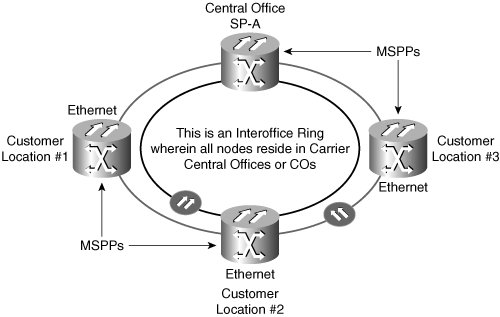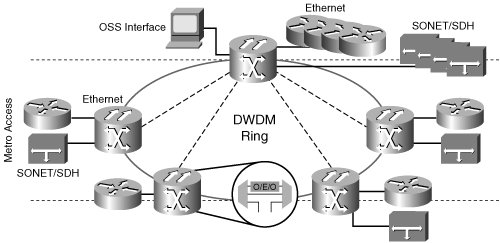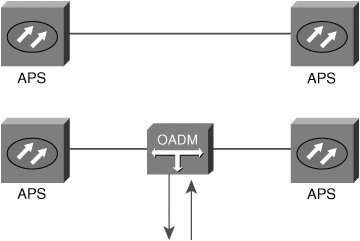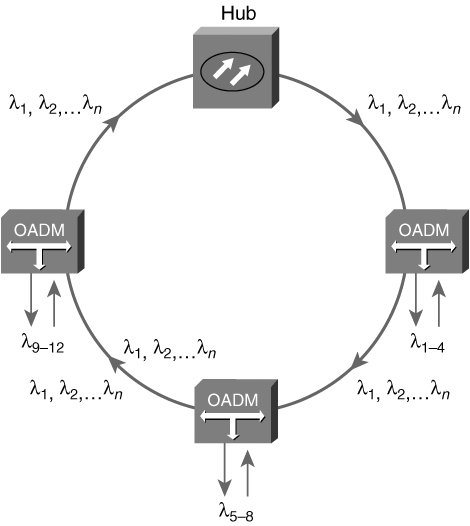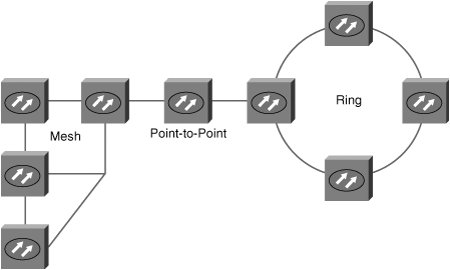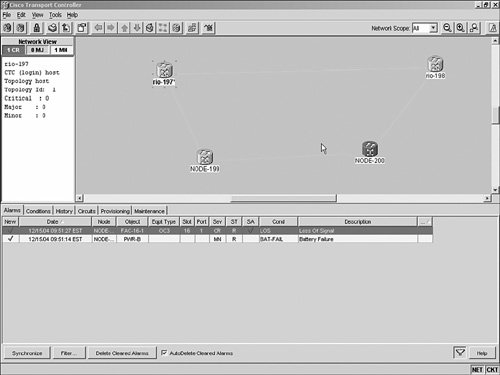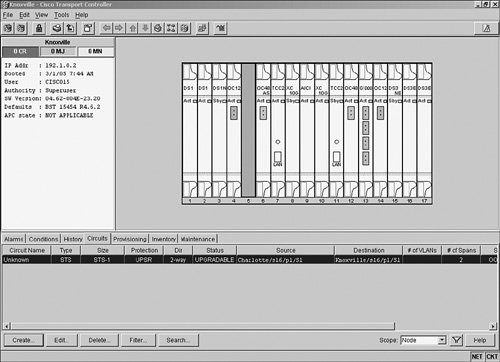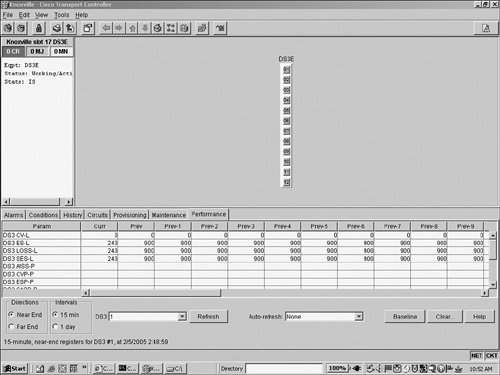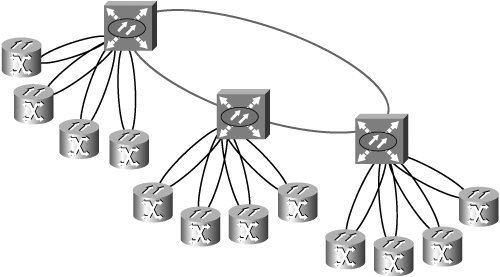MSPP Positioning in Service-Provider Network Architectures
| MSPP brings with it the capability to deploy traditional unidirectional path-switched ring (UPSR) and BLSR ring architectures. It also has introduced the capability to use the MSPP in what is called a path-protected meshed network (PPMN), shown in Figure 4-16. Figure 4-16. PPMN Network That Uses a Meshed Protection Scheme to Protect the Network Note Although this chapter focuses on the traditional UPSR and BLSR ring deployments of MSPP in the forthcoming sections, a brief introduction to PPMN is relevant because PPMN offers a valuable alternative to the traditional ring types. PPMN allows network designers to design a mesh that uses both protected and unprotected spans at various line rates. If one route fails, connection is reestablished through another path in the mesh in less than 50 ms. This offers network designers the flexibility they can use for mesh networks today. A meshed network refers to any number of sites randomly linked together with at least one loop. In other words, each network element has two or more links connected to it. How MSPP Fits into Existing NetworksThe magnificence of MSPPs is that they offer physical Layer 1 services, media access Layer 2 services, and even network Layer 3 features such as QoS. This allows MSPPs to fulfill a number of service needs while integrating various service types into one platform that can aggregate and backhaul these services through either a carrier's network or even a customer's private network. The next sections look at how MSPPs are integrated into the networks and the value they add. MSPP IOF RingsEnough cannot be said of the value MSPP has brought to carrier IOF rings. To review the differences between legacy optical platforms and today's highly enhanced MSPPs, take a look at Chapter 1, "Market Drivers for Multiservice Provisioning Platforms." Next, you will look at two major IOF deployments: DWDM and SONET. You will see that MSPP has revolutionized each by decreasing costs and provisioning time, while increasing flexibility and scalability. Figure 4-17 shows an IOF ring using MSPPs. Figure 4-17. MSPP Used as the Backbone for IOF DWDM TransportAs shown in Chapters 1, "Market Drivers for Multiservice Provisioning Platforms," and 3, "Advanced Technologies over Multiservice Provisioning Platforms," DWDM transport is now integrated into today's MSPPs, allowing for wavelengths to be launched from the MSPP. IOF DWDM transport types are deployed as either passive or active DWDM from the MSPP. Because DWDM uses specific wavelengths or lambdas for transporting data, the lambdas provisioned must be the same on both ends of any given connection. The International Telecommunications Union (ITU) has standardized on a grid with spacings of 100 GHz; however, vendors use wider spacing, sometimes at 200 GHz or narrower. In addition, different vendors that do use the same grid might not use the same lambda-numbering scheme. That is, wavelength A on one vendor's equipment could be assigned a different wavelength number from wavelength B on another vendor's equipment. Hence, it is important to be aware of these potential interoperability problems that stem from different grid alignments. IOF passive DWDM transport uses a combination of ITU wavelength optics in the MSPP and "off-the-shelf" filters in what is typically called a passive MSPP DWDM deployment because the filters do not reside on the MSPP. IOF active DWDM transport is a deployment in which the filters reside on the MSPP and can be integrated into a complete DWDM ring using MSPPs, as shown in Figure 4-18. Figure 4-18. MSPP-Based Active DWDM Example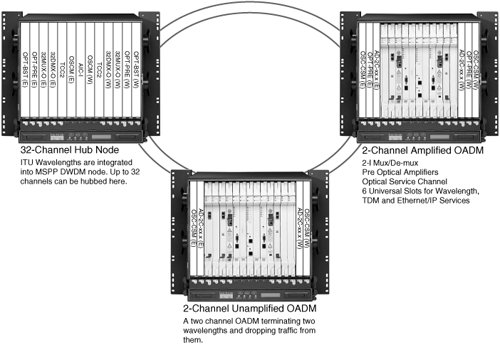 Before the emergence of MSPPs, two separate networks had to be built: a DWDM overlay network and a SONET ring to groom the traffic from the DWDM wavelengths. This is no longer necessary because the MSPP optical add/drop multiplexers (OADMs) can both terminate the wavelength and carve out the SONET traffic to be delivered from the MSPP. Thus, in an IOF MSPP DWDM transport application, one integrated DWDM/SONET platform can take the place of what used to be two or more devices. If an MSPP does not have DWDM capabilities, it can be upgraded, thus making it scalable and protecting the carrier's investment. SONET TransportToday's SONET IOF rings benefit greatly from the flexibility and density, footprint and power requirements, scalability, and ease of provisioning and management of MSPPs. Descriptions of each of these benefits as they pertain to the SONET IOF are as follows:
MSPP Private ArchitecturesJust as MSPP has been deployed for the service-provider IOF rings, it is being deployed today with great success and growing demand as the infrastructure of choice for private rings, which are used to deliver services such as Ethernet over SONET, storage, TDM services, and wavelength services. The architectures for each ring type are covered in the next few sections. EthernetLooking at Figure 4-19, you can see once again that MSPP nodes act to terminate the fiber from the service provider that owns the fiber and the MSPPs in the CO, and even at the customer premises. Figure 4-19. MSPP Used to Deliver Ethernet Services Regardless of the type of service deployed from the MSPPfor example, Ethernet Private Line (EPL), Ethernet Wire Service (EWS), Ethernet Relay Service (ERS), Ethernet Multipoint Service (EMS), Ethernet Relay Multipoint Service (ERMS), or Resilient Packet Ring (RPR)the ring architecture is the same. The only difference among services being offered lies in the card type and the provisioning of the software. The ports off the MSPP connect to the customer-owned premises equipment. In a traditional SONET mapping application in which the Ethernet data is mapped into the SONET payload, multiport cards in the MSPP are used to terminate the Ethernet connection to the CPE, as shown. Figure 4-20 shows MSPP and CPE in the customer premises, with MSPP owned by the carrier. Figure 4-20. MSPP and CPE in the Customer Premises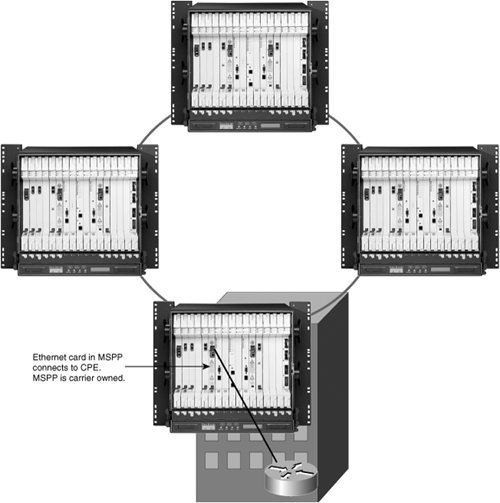 In an Ethernet RPR configuration, the ring nodes act as packet switches implementing a Layer 2 protocol for media access and bandwidth sharing. RPR uses both primary and back-up rings for data. Although this capability to use both primary and back-up rings is a capacity advantage for RPR, it comes at a price. Fault recovery, in the case of RPR, is always accompanied by loss of service (LoS). While the faulty ring is being repaired, all data transmission on that ring is disrupted, and service to the customer is stopped until the fault is isolated and fixed. This might be acceptable for casual network use, but revenue-generating services cannot meet their service-level requirements without a prioritization scheme. Thus, in the case of a fiber cut or a node failure, RPR networks must continue to provision bandwidth for high-priority traffic, such as voice, while applying fairness and buffering for low-priority data traffic, such as e-mail or file transfers. In a ring architecture, when restoration occurs after a single fiber cut, unidirectional rings and 4-Fiber bidirectional rings continue sustaining the same amount of bandwidth after restoration as before. This is made possible because the same amount of bandwidth required to restore service after the cut was being held in reserve before the cut. For the 2-Fiber BLSR, the network throughput remains the same, except when the number of nodes is even and the demand is not split. In this case, curiously, the demand supported before the cut is less than the demand that can be supported after the cut. The RPR ring is a bidirectional dual counter-rotating ring and, thus, is similar to a 2-Fiber BLSR. But because the entire bandwidth is used for working traffic (that is, no bandwidth is set aside for protection unlike in a 2-Fiber BLSR), the network throughput is equal to that of a 4-Fiber BLSR. After a fiber cut/restoration, the wrapped ring is exactly the same as a wrapped 2-Fiber BLSR. Therefore, after restoration, network throughput of an RPR ring drops by half. Storage-Area NetworkingStorage-area networking private rings offered by service providers are relatively new, given that the technology required to deliver this service has not been available until recently. Figure 4-21 shows a typical SAN private ring application. Figure 4-21. SAN Private Ring Offered by a Service Provider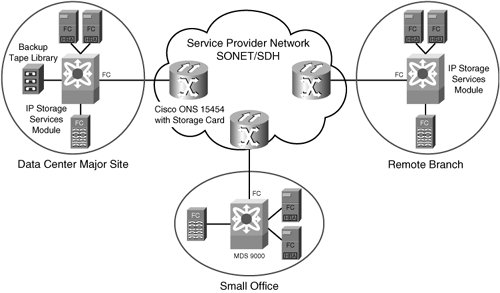 Looking at Figure 4-21, as in the case with private Ethernet rings, the carrier owns and operates the SONET MSPPs. The storage cards with interfaces reside within the MSPP chassis, and they offer the termination points for the Fibre Channel (FC) connections. The ring can be configured in any one of a number of ring topologies:
In a 4-Fiber BLSR, two fibers are reserved as a protection ring, and the other two other fibers are used as the working ring. In a 2-Fiber BLSR, data between two neighboring ring nodes is sent in both directions because it is bidirectional. But because no additional pair of fibers exists to serve as a protection ring, half the time slots on each fiber are reserved as protection bandwidth. Regardless of the private ring service being offeredEthernet, storage, TDM, or optical servicesthe carrier has the option of using a 2- or 4- Fiber deployment for the ring architecture. TDMTDM traffic over SONET was the primary driver behind traditional SONET platform growth long before MSPPs arrived on the scene. Today MSPPs continue to carry a plethora of TDM circuits throughout the SONET networks. The SONET equipment is most often deployed in rings for TDM traffic. The ring allows services to be routed either way around the ring so that if a fiber is cut or an SONET OADM fails, the service can be rerouted via the other half of the ring. Point-to-point connections are also allowed and can be protected using two pairs of fibers. Finally, a linear topology is another option, with a sequence of MSPPs interconnected in a chain. Leased lines can be provided as protected or unprotected services. Different levels of protection exist, depending on the type of protection mechanism that is provided in the network devices. The ring architectures that a carrier can use to deliver TDM traffic to customers in a private ring deployment are similar to these familiar ones:
For TDM private rings, UPSR rings dominate the landscape. UPSRs are popular topologies in lower-speed local exchange and access networks, particularly where traffic is primarily point to multipointthat is, from each node to a hub node, and vice versa. The UPSR is an attractive option for TDM applications because of its simplicity and lower cost. No specified limit exists on the number of nodes in a UPSR or on the ring length. In practice, the ring length is limited by the fact that the clockwise and counterclockwise paths that a signal takes have different delays associated with them; this affects the restoration time in case of failure. UPSRs are fairly easy to implement because their protection scheme is simple: It requires action only at the receiver, without any complicated signaling protocols. As in the case of Ethernet private rings and SAN private rings, the carrier owns the MSPPs and connects to the CPE equipment, which is titled to the customer. A TDM ring can be exclusively DS1s, DS3s, or a combination of the two. With MSPP, the underlying ring architecture is not a factor for the TDM service type. Wavelength ServicesThe ring architecture for DWDM has the same options as the other private ring deployments. UPSR, 2-Fiber BLSR, and 4-Fiber BLSR are the most common deployments. In a wavelength service, the carrier owns the MSPPs and hands off a wavelength from the MSPP to the customer premises equipment, as Figure 4-22 shows. Figure 4-22. MSPPs Owned by Service Provider and Handing Off Wavelength to Customer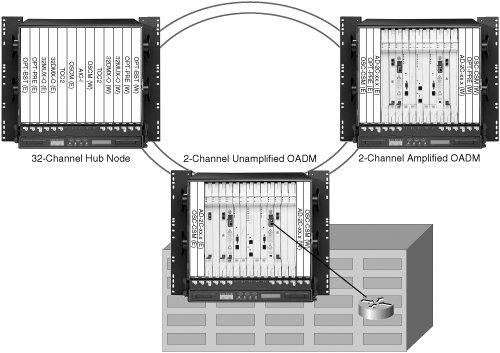 MSPP Access RingsMany service providers are gaining incredible benefit by deploying MSPPs in their access network. With many customers and service types being aggregated into this network, MSPPs offer incredible flexibility, scalability, and the capability to rapidly launch new services from the access rings to the end users. Next you will take a look at how MSPPs have enhanced the ring architecture for carrier access rings. MSPPs in the access network can be used to deliver services to customers using either SONET, CWDM, or DWDM infrastructures, or a combination of these technologies off the same shelf. SONET Access Ring ArchitectureThe proliferation of MSPP SONET access rings is growing rapidly. The same features and cost benefits found in an MSPP IOF ring for a carrier are available in the access part of the network. The only difference is the size of the MSPP. Equipment vendors typically offer their flagship MSPP, which provides the highest number of slots and is the largest footprint; then they offer a smaller version, or "MSPP Jr.," which is scaled down for smaller applications. This gives the service provider a lower-cost price point to justify the system architecture from a business standpoint, allowing them to recoup their initial capital expenditure investment in a shorter period of time. An example of this is the Cisco ONS 15454, which is the flagship MSPP, and the ONS 15327 (shown in Figure 4-23), the smaller version of it. Both platforms use the same management system, the Cisco Transport Controller (CTC); network nodes for each platform can be accessed and provisioned simply by changing the IP address. Figure 4-23. Cisco ONS 15327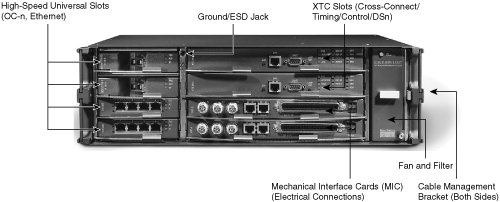 As far as the ring architecture go, MSPPs can use point-to-point, UPSR, BLSR, or mesh topologies to deliver SONET access services. CWDM Access Ring ArchitectureBroadband CWDM access technologies enable service providers to quickly deploy metro services to customers at unprecedented price points. CWDMs are one of the most cost-effective access solutions, and they can be deployed either as point-to-point feeders or as access rings with hubbed traffic patterns. Service providers add bandwidth and wavelengths as needed. In access ring applications, advanced features, such as single-wavelength add/drop and low-cost path protection, are available. This enables the service provider to offer metro services with maximum flexibility and high reliability. In a CWDM application, fiber to the buildings must be available to terminate the fiber in the customer premises. If it is not available to the building, an intermediate terminal site must exist to drop the wavelength and then carve the services out of the MSPP to be delivered to the customer premises over a copper facility. In this case, the CWDM access ring acts as a core aggregator of services coming from the customer premises; then these services are backhauled into the CWDM core, with the MSPP embedding the STSs into the CDWM wavelength. A CWDM ring built on MSPPs, shown in Figure 4-24, enables service providers to do the following:
DWDM Access Ring ArchitectureA DWDM access ring architecture is just like that of a CWDM access ring: The only difference is the channel spacing of the wavelengths on the ring. The cost of a DWDM access ring has been traditionally prohibitive; however, with the emergence of MSPP, it is becoming more viable to implement in a cost-effective manner. Nonetheless, a business case for a DWDM access ring would still require a highly dense population of high-bandwidth users within a given geographic area, such as a major metropolitan area with many high-rises in which the DWDM wavelengths could be terminated in the buildings and the MSPP can distribute services to multiple tenants. At the same time, bandwidth demand is growing among end users, with applications such as voice, video, and storage requiring larger pipes to carry the data. Figure 4-25 shows a carrier DWDM access ring using MSPP, as already shown. In the next section, you take a look at a three MSPP-based DWDM service provider access architectures, including point-to-point, ring, and mesh architectures. Figure 4-25. Carrier DWDM Ring Point-to-Point MSPP-Based DWDM Service Provider Access ArchitecturePoint-to-point DWDM topologies can be implemented with or without OADM. These networks are characterized by ultra-high-channel speeds of 10 Gbps to 40 Gbps, high-signal integrity and reliability, and fast-path restoration. In long-haul networks, the distance between transmitter and receiver can be several hundred kilometers, and the number of amplifiers required between endpoints is typically less than 10. In metropolitan-area networks (MANs), amplifiers are often not needed. Protection in point-to-point topologies can be provided in a couple ways. In legacy equipment, redundancy is at the system level. Parallel links connect redundant systems at either end. Switchover in case of failure is the responsibility of the client equipment (a switch or router, for example); the DWDM systems themselves just provide capacity. In next-generation MSPPs, redundancy is at the card level. Parallel links connect single systems at either end that contain redundant transponders, multiplexers, and central processing units (CPUs). Here protection has migrated to the DWDM equipment, with switching decisions under local control. One type of implementation, for example, uses a 1+1 protection scheme based on SONET APS, as shown in Figure 4-26. This can be used for access from a high-rise to a service provider's central office. Figure 4-26. Point-to-Point Architecture MSPP-Based DWDM Service-Provider Access Ring ArchitectureDWDM access rings are the most common DWDM architecture found in metropolitan areas; they span a few tens of kilometers. The fiber ring might contain as few as four wavelength channels and typically fewer nodes than channels. Bit rate is in the range of 622 Mbps to 10 Gbps per channel. Ring configurations can be deployed with one or more DWDM systems, supporting any-to-any traffic, or they can have a hub node and one or more OADM nodes, as shown in Figure 4-27. As the hub node traffic originates, it is terminated and managed, and interfaces with other networks are established. At the OADM nodes, selected lambdas are dropped and added, while the others pass through transparently. In this design, ring architectures allow nodes on the ring to provide access to customer premises equipment, such as routers, switches, or servers, by adding or dropping wavelength channels in the optical domain. With an ever-increasing number of OADMs, however, comes an ever-increasing signal loss, and amplification can be required. Figure 4-27. DWDM Hub and OADM Ring Architecture Candidate networks for DWDM deployments in the metropolitan area are often already based on SONET ring designs with 1+1 fiber protection. Thus, schemes such as UPSR and BLSR can be reused for DWDM implementations. Figure 4-28 shows a UPSR scheme with two fibers. Here, a central office hub and nodes send data on two counter-rotating rings, but all equipment normally uses the same fiber to receive the signalhence, the name unidirectional. If the working ring fails, the receiving equipment switches to the other pair of fibers. Although this provides full redundancy to the path, no bandwidth reuse is possible because the redundant fiber must always be ready to carry the working traffic. This scheme is most commonly used in service-provider MSPP-based DWDM access networks. Figure 4-28. UPSR Protection on a DWDM Ring Other schemes, such as BLSR, allow traffic to travel from the sending node to the receiving node by the most direct route. As you have seen in our IOF discussion, BLSR is considered preferable for core SONET rings, especially when implemented with four fibers, which offers complete redundancy. Mesh TopologiesMesh architectures are the future of optical networks. As MSPPs have emerged, rings and point-to-point architectures still have a place, but mesh promises to be the most robust topology. From a design standpoint, there is an elegant evolutionary path from point-to-point to mesh topologies. By beginning with point-to-point links equipped with MSPP nodes at the outset for flexibility, and subsequently interconnecting them, the network can evolve into a mesh without a complete redesign. Additionally, mesh and ring topologies can be joined by point-to-point links, as shown in Figure 4-29. Figure 4-29. Mesh, Point-to-Point, and Ring Architectures Service-provider MSPP-based DWDM meshed access network architectures, which consist of interconnected all-DWDM nodes, require the next generation of protection. Where previous protection schemes relied upon redundancy at the system, card, or fiber levels, redundancy now must transition to the wavelength itself. This means, among other things, that a data channel might change wavelengths as it makes its way through the network, due either to routing or to a switch in wavelength because of a fault. The situation parallels that of a virtual circuit through an ATM cloud, whose virtual path identifier (VPI)/virtual channel identifier (VCI) values can be altered at switching points. In optical/DWDM networks, this concept is occasionally called a light path. Service-provider MSPP DWDM meshed access networks therefore require a high degree of intelligence to perform the operations of bandwidth management and protection, including fiber and lambda switching. This flexibility and efficiency are profitable. For example, fiber use, which can be low in ring solutions because of the requirement for protection fibers on each ring, can be enhanced in a mesh design. Protection and restoration can be based on common paths, thereby requiring fewer fiber pairs for the same amount of traffic and not wasting unused wavelengths. Finally, service-provider MSPP DWDM meshed access networks are highly dependent upon software for management. MPLS can now support routed paths through an all-optical network. Next-Generation Operational Support SystemsMSPP next-generation operational support systems (NGOSS) have been designed to deliver multilevel operations, administration, maintenance, and provisioning (OAM&P) capabilities to support distributed and centralized operation models. With the objective of providing rapid response to service demands while achieving low initial cost and ongoing operational costs, the MSPP NGOSS requirements need to complement legacy and other NGOSS architectures by providing an array of options to support the diverse customer platform needs. OAM&P FunctionalityMSPP NGOSS has expanded the industry's management functionality by combining add/drop multiplexor (ADM), digital cross-connect, DWDM, and data capabilities. This management approach provides a number of options, which complement the legacy management architectures while providing more functionality at each level. The most significant OAM&P options that NGOSS supports include these:
Craft Management SystemMSPP NGOSS expands the level of functionality of traditional craft systems by including extensive element- and network-level management capabilities. These include fault management, configuration management, accounting management, performance management, and security management (FCAPS), as well as circuit management across multiple data communication channels (DCC)connected and data communication network (DCN)connected nodes. A significant feature called "A to Z Provisioning" allows provisioning across a domain of MSPPs, including optional auto-routing of circuits. Most of today's MSPP OSSes provides instant-on, anywhere management with a user-friendly, point-and-click GUI. MSPP OSSes also connect to network elements (NEs) over a Transmission Control Protocol/Internet Protocol (TCP/IP) DCN and over the SONET DCC. For example, CTC, the Cisco ONS 15454 MSPP OSS, can autodiscover DCN and DCC-connected ONS 15454 and 15327 nodes. It provides graphical representations of network topology, conditions, and shelf configurations. CTC is launched from any platform running a JDK 1.3compliant Java Web browser, including both Microsoft Windows PCs and UNIX workstations. Operations staff and craft personnel in the Network Operations Center (NOC), the CO, or the field primarily use the craft interface functionality of MSPP OSS as a task-oriented tool. Its main functions are the installation and turn-up of NEs, provisioning of NE and subnetwork resources (such as connections/circuits within the subnetwork), maintenance of NE and subnetwork resources, and troubleshooting or repair of NE faults. MSPP NGOSS Craft Interface FunctionalityThe craft interface of MSPP OSS provides extensive coverage for FCAPS as follows:
SNMP and TL1 InterfacesMany NGOSSes include standard SNMP interfaces that can be used for fault management, including autonomous alarm and event reporting, of the ONS 15454. These interfaces support gets and traps using SNMPv1 and SNMPv2c. The SNMP interface is based on Internet Engineering Task Force (IETF) standard Management Interface Blocks (MIBs). NGOSSes also include a standard TL1 interface that can be used for command-line configuration and provisioning, as well as autonomous alarm and event reporting. OSMINE CertificationTelcordia (formerly Bellcore) uses the OSMINE process to certify network element compatibility with their OSSes. NGOSSes that are placed in operation within RBOCs that require vendor equipment to be "OSMINEd" have completed the OSMINE process. Common Language Equipment Identification (CLEI) and function codes exist for all equipment. TIRKS, NMA, and TEMS have been integrated into the NGOSSes. EMSDespite the powerful functionality of MSPP OSS craft interfaces, they are not EMSes; they are complementary to but are not a replacement to an EMS. The following are some of the traditional EMS functions that MSPP NGOSSes provide:
Additionally, MSPP NGOSS EMSes provide GUIs for easy point-and-click management of the MSPP network. Comprehensive FCAPS support includes inventory management, in which the inventory data is stored in the MSPP NGOSS database and is available for display, sorting, searching, and exporting through the GUIs. Finally, MSPP NGOSSes provide seamless integration with existing and next-generation network-management system OSSes by using open standard interfaces, which offer the ultimate management flexibility for all the service-provider telecommunications network-management layers. Multiservice Switching PlatformsAn evolving technology platform that has emerged from the proliferation of MSPPs is the Multiservice Switching Platforms (MSSPs). The undeniable success of MSPPs has created another revolution in bandwidth and traffic patterns, creating the need for a new switching platform optimized for the metropolitan area to aggregate and switch that higher-bandwidth traffic. As already shown, higher-bandwidth services are now starting to dominate the metro, and the management of bandwidth has transitioned to STS levels, in contrast to DS0s and T1s, as shown in Figure 4-34. The introduction of the MSSP has taken this design approach one step further. The MSSP provides far more efficient scaling in large metropolitan areas. The MSSP also enables more bandwidth in the metro core for an even greater density and diversity in higher-bandwidth services. Finally, the MSSP unleashes the additional service potential found within the MSPP multiservice traffic originating at the edge of the metro network, and can now be aggregated through a single, scalable, multiservice network element at metro hub sites, as shown in Figure 4-35. Figure 4-34. Growth in Metropolitan Traffic Figure 4-35. MSSP at Core of Optical Network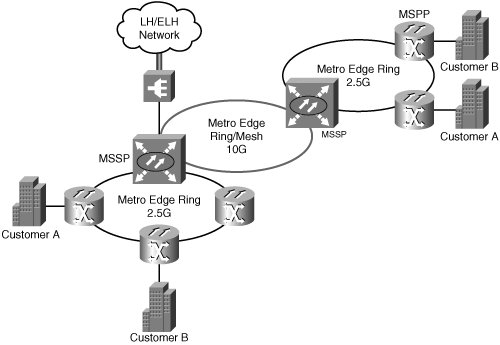 The MSSP is a true multiservice platform. MSSPs have interfaces, such as OC-48/STM-16 and OC-192/STM-64 for the high-bandwidth metro aggregation, as well as interfaces for Ethernet and integrated DWDM. This multiservice capability allows carriers to use their existing SONET infrastructure while supporting current TDM services, and carriers can move the benefits of next-generation services, such as Ethernet, into the central office. The multiservice functionality also gives the MSSP and the MSPP tighter integration, allowing the service provider to carry the strengths and benefits of an MSPP from one end of the optical network through the metro core and out to the other end of the network, as shown in Figure 4-36. Figure 4-36. Illustration of the Optical Network and the Placement MSSPs The MSSP must be capable of leveraging integrated DWDM functionality in addition to its data-switching capabilities. Integrated DWDM allows carriers to accomplish more in a single switching platform by minimizing the need to purchase another appended transponder to place traffic onto the DWDM infrastructure. By offering integrated DWDM, Ethernet, and STS switching capabilities in a single switching platform, a service provider can place the MSSP in the central office and use it not only for today's STS switching and interoffice transport demands, but also for generating additional high-margin services as they are requested. MSSPs need to support variable topologies and network architectures, just as MSPPs do. Thus, MSSPs support 1+1 APS, UPSR, BLSR, and PPMN, as shown in Figure 4-37. Figure 4-37. Topologies Supported by MSSP To aggregate the numerous high-speed metropolitan rings, the MSSP needs a high port densityin particular, OC-48 and OC-192, the predominant metro core interfaces today. MSSPs also remove intershelf matrix connections to achieve a footprint that is greatly reduced compared to that of legacy broadband cross-connect systems. The small footprint of the MSSP not only provides savings for the service provider, but it also authenticates that the MSSP is a huge technological advancement. MSSP provisioning times are comparable to those on today's MSPP network. Integration with existing MSPP provisioning software is key to reducing provisioning times and providing a common management look and feel for network operators. Some of the key functions are as follows:
|
EAN: 2147483647
Pages: 140

